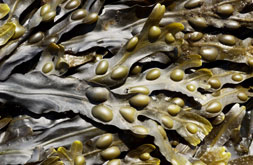The Seamoss Cartel
Bladderwrack (Fucus vesiculosus)
Bladderwrack (Fucus vesiculosus)
Couldn't load pickup availability
Fucus is northern-hemisphere genus of macroscopic marine seaweeds called wracks. It includes a relatively small number of species. Fucus vesiculosus is perhaps the best-known species (below), is known to have a number of useful compounds. The plants consist of a flattened, dichotomously-branched thallus which has a small stipe and a holdfast. The blade usually has a locally-thickened area which is centrally placed called a midrib. Air bladders are  found in some species and these help to keep the plant afloat when submerged.
found in some species and these help to keep the plant afloat when submerged.
There is no conducting tissue in Fucus: it is unecessary as the plant is small enough to be able to manufacture food locally. In these brown algae the plants are always diploid and meiosis takes place before the gametes are formed. Gamete production takes place in specialised crypt-like structures called conceptacles which are borne in fertile, swollen areas at the tips of the plants: these are called receptacles. It is very easy to confuse these two terms.


